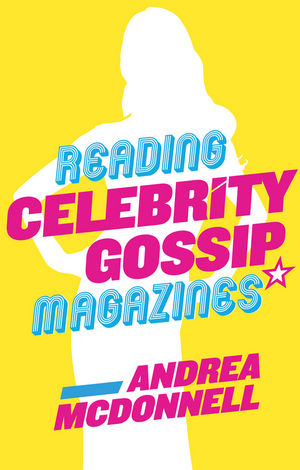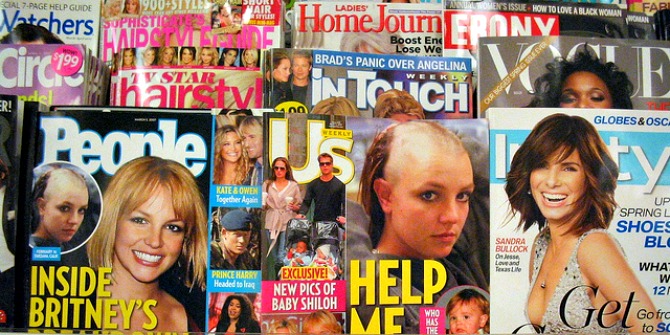Celebrity gossip magazines continue to sell millions of issues each week. What attracts us to these magazines? And why do we read them, even when we disagree with the images of femininity that they splash across their covers? Andrea McDonnell offers readers of media studies and gender studies a fascinating – if somewhat underdeveloped – analysis, writes Ruth Garland.

Reading Celebrity Gossip Magazines. Andrea McDonnell. Polity Press. 2014.
Andrea McDonnell is a young media scholar who makes no secret of her passion for her subject, and her determination to persuade the academic community and the casual reader that celebrity gossip magazines are a subject worthy of serious study. In this readable book which runs to 137 lively pages, she provides us with an (almost) 360 degree case study of five US gossip magazines at a particular moment in time, interviewing magazine editors, talking to a group of readers, and examining the texts.
The five magazines – US Weekly, Star, Life & Style, In Touch and OK – are, with the exception of the latter, not known in the UK, but the ingredients are familiar. As a fan of gossip magazines, and an office worker, McDonnell would share her views on their contents with colleagues over lunch, taking what seemed to be a harmless pleasure in them, but becoming “troubled” by the way they treated one of her favourite celebrities, the Simple Life reality star Nicole Richie. Like our own Peaches Geldof, Nicole was attacked for being too fat, too thin, and then hailed as an “earth mother”, thus fitting into the magazines’ version of the contemporary fairy tale, the “transformation narrative”.
Throughout the book, McDonnell asks herself a series of questions: why do clever and media savvy women, including “self-avowed feminists” like her read these texts? Why do we talk about the some of the most powerful and successful women in society in terms of a “neurotic obsession with cellulite”? How can celebrity stories which “obsess, nit-pick and scrutinize us” be fun to read?” She goes a long way towards answering the final question, which is an achievement in itself, but I think presents an overly positive view of the genre which makes it hard for her to satisfactorily grapple with its potentially wider and more damaging effects.
She firmly places celebrity gossip magazines within the realm of the “popular feminine”, which includes TV reality shows, soaps and so-called ‘chick flicks’ and ‘chick lit’, and which is routinely dismissed as ‘trash’. Quoting Janice Winsip, she argues that: “to dismiss women’s magazines was also to dismiss the lives of millions of women who read and enjoyed them each week.” In fact, she contends, it is the complex brew of escapism, scepticism, guilty pleasure and self-criticism which together provide the readers with a deep, conflicted and nuanced form of pleasure. As she hears from her focus group of 11 women readers, it is a form of pleasure which uses the celebrity persona to fulfil individual and groups needs by facilitating the sharing of specifically “female life choices and desires” and the airing of subjects that otherwise would be too painful to discuss.

Her analysis of how the editors construct this potent “narrative realm” and “stitch” the readers into the narrative is fascinating but somewhat one-dimensional. In her in-depth interviews with six senior editors, they claim that audience response plays a “critical” role in determining editorial decisions – a claim made throughout the industry – but she doesn’t back this up. Her data on circulation is sporadic rather than comprehensive, although she makes interesting and surprising points, like the fact that nearly a quarter of the genre’s readership is male, and that every issue of US Weekly is read by an average of seven people. The editorial significance of revenue from advertising being more important than cover price is not dealt with here.
She touches on the selling power of the celebrity image, quoting industry specialist Judith Newman as saying: “the difference between an ok-selling cover and a great cover is about half a million dollars. In one week”. Similarly, she describes the celebrity gossip press as “one of the key sites of image production”, and accepts the view of her editorial interviewees that “many stars have become active participants in the production of gossip narratives”. For a real 360 degree analysis, it would have been interesting to hear the views of the stars and their PR agents on what it is really like to be an “avatar” for other peoples’ experiences.
As if to underline McDonnell’s point that these magazines provide a shared experience, while reading the book in a local café, I was approached by an American, attracted by its bright yellow, pink and blue cover (the colour palette of US Weekly), saying: “is there really a book called Reading Celebrity Gossip Magazines?” I looked up from page 36 where I was reading about “the almost total dismissal of and hostility towards narrative genres which are very popular among women” and said that, actually, these publications are market leaders here and in the States and very important culturally. There was a slight frisson but we ended up talking about George Clooney’s wedding.
To make one final point. Jann Wenner is the owner of the US Weekly stable. In 1970 he conducted one of the most memorable pieces of celebrity journalism – the first post-Beatle interview for Rolling Stone with John Lennon and Yoko Ono. Haven’t we come a long way?
Ruth Garland is a researcher and PhD student in Media & Communications at the London School of Economics, having returned to study after 25 years working in media relations in publishing, broadcasting, public health and local government. She is researching into government communications. Read more reviews by Ruth.








2 Comments